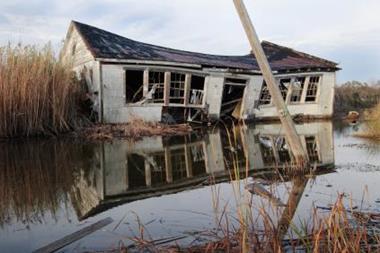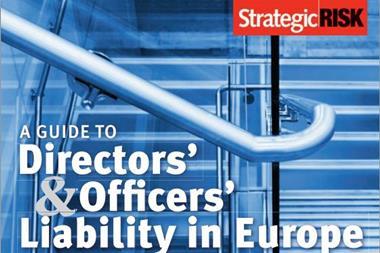Hurricane Katrina was the single largest loss in the history of the insurance industry. Its place in the annals of insurance is also secure by virtue of it being the single most litigated loss on record. By Claire Wilkinson
Litigation arising from this $41.1 billion insured event created a near catastrophe of its own, precisely because it could have unraveled tens of thousands of insurance contracts. In its simplest form, the starting point for the post-Katrina legal storm was the long standing and explicit flood exclusion in standard homeowners' policies in the United States.
The subsequent scrutiny of the flood exclusion and other provisions of policy language threatened to undermine the entire legal core of the industry and to add billions of dollars to the claims already paid by insurers. Let's not forget that just defending the litigation has cost insurers substantial additional billions of dollars in time and money.
Amid the thousands of insurance stories written on Katrina, it is litigation - more than any other aspect of this disaster - that has dominated the news headlines. This has come at a high public relations cost to the industry, in particular because the post-event litigation has dragged on over the course of two years and accounted for the vast majority of negative press in the first 16 months after the storm.
Yet, despite heightened publicity over lawsuits seeking payments for damage under insurance policies where no coverage exists, the number of Katrina claims litigated actually accounted for a very small percentage of the total number of claims filed. Insurers have also won virtually every major case in the post-Katrina litigation environment, establishing or reaffirming important legal precedent in each instance.
Claims update
According to Insurance Information Institute (III) estimates, less than two percent of Katrina homeowners' claims in Louisiana and Mississippi were disputed either through mediation or litigation. This is no mean feat considering the unprecedented size and complexity of this catastrophe, which caused insurers to pay 1.75 million claims for damage to homes, businesses and vehicles in six states, totaling $41.1 billion. By contrast, Hurricane Andrew, the previous record holder, was effectively half the size of Katrina with $15.5 billion in losses in 1992 ($22.2 billion in 2006 dollars) and 790,000 claims.
Katrina claims settlement levels have been extremely high. By the second anniversary of the disaster, approximately 99% of the 1.2 million homeowners' claims, including those in hard hit Louisiana and Mississippi, had been settled. Effectively all of the nearly 350,000 claims from damaged vehicles, totaling $2.2 billion, have been settled. Some 156,000 commercial claims accounted for $20.5 billion in claims payments to businesses.
Customer satisfaction with insurers also appears to have been relatively high. For example, a poll conducted by IPSOS Public Affairs in 2006 found that 89% of homeowners in Louisiana and 93% in Mississippi were satisfied with their insurance companies.
The survey reported that four in five people (82% in Louisiana and 80% in Mississippi) who filed a hurricane related claim were satisfied with the way it was managed by their insurer. While satisfaction numbers were slightly higher inland, most residents in the hardest hit coastal areas described themselves as satisfied with the way their claim was handled.
Litigation onslaught
The first lawsuit arising from Hurricane Katrina was filed just days after the event by Mississippi attorney general Jim Hood against several homeowners and property insurers. In the suit, he sought to force insurers to pay for flood insurance losses under homeowners' contracts, alleging that the flood exclusions in these policies were void and unenforceable.
Many of the subsequent actions against insurers followed a similar pattern in that they attempted to take another bite out of the flood exclusion or the broader issue of wind versus flood losses.
Such cases can be complex for a number of reasons. Firstly, insurers can have difficulty excluding flood when both wind and flood are involved in damaging a home because it is difficult to differentiate between two causes.1 Another critical element is that a well established principle of insurance law holds that ambiguities regarding coverage tend to be settled in favour of the policyholder and based on state law.
A further dimension of the post-Katrina litigation is the additional attention and scrutiny given to a long standing provision of homeowners' insurance policy language, known as the anti-concurrent causation or ACC clause.
In layman's terms, the ACC clause says that any damage caused in part by an uncovered peril (i.e. flood) will not be paid for by insurers. Taken literally, this suggests there is no coverage at all if flooding contributed in any way to the damage because flood is an uncovered peril. Disputes arose around the ACC clause because of disagreements over whether damage was caused by wind or flood. This was a critical issue because of the tremendous storm surge (up to 28 feet or 8.6m) in some coastal areas.
Levees
Another key aspect of the post-Katrina cases filed against insurers concerns the floods that followed the breaks in the New Orleans levees and whether or not they could be considered a natural event or the result of a man-made disaster. The legal theory in these cases is, perhaps, one of the most dubious that the industry has had to defend.
Although flood damage is an excluded peril whether it is considered an act of God or an act of man, a November 2006 ruling by US District Court Judge Duval decided otherwise.2
The judge said that the New Orleans levee breaks were not a flood and should be covered by some insurers based on their policy language. If upheld, this ruling could have cost the insurance industry an estimated $2 billion to $3 billion in additional payments.
However, in an extremely important ruling on 2 August 2007, the Fifth US Circuit Court of Appeals overturned the lower court's decision. It held that the flood exclusions in the various policies were not ambiguous, although they did not distinguish between flooding caused by an act of God and flooding caused by an act of man. Ultimately, the court held that flood losses, were excluded from homeowners' insurance policies, whether the levee breach was man made or an act of God.
Summary
Litigation risk can be extremely costly to all businesses and the insurance industry is no exception. In the wake of the largest loss in insurance history, insurers have been subject to ongoing pressure by the public, Congress and the judicial system, to settle outstanding Katrina cases. Yet, insurers have won virtually every major case post-Katrina.
That said, while the magnitude of Hurricane Katrina has led to a fundamental reassessment of risk, it is also the case that the wave of litigation arising from this event should spur further industry discussion on, and reassessment of, policy language. After all, a recurrent theme in much of the post-Katrina litigation has been the perceived ambiguity of policy language.
Insurance policies may be binding legal contracts that have stood the test of time, but they also need to move with the times and ultimately provide greater clarity for policyholders. This issue will be of growing importance as insurers look to prepare for future projected hurricane seasons of increasing frequency and severity. Indeed, in the event of the $100 billion catastrophic event, insurers will, more than ever, need to rely upon the language underpinning the policies they have issued.
Case focus
Different post-Katrina legal cases highlight different aspects of the wind versus flood issue. But a common feature is that if successful, they could have left insurers exposed to billions of dollars of additional payments. It is worth noting that the National Flood Insurance Program (NFIP), operated by the federal government, incurred more than $20 billion in losses and a deficit exceeding $18 billion as a direct result of Katrina flooding, even though the majority of people in affected areas had not purchased flood insurance.
Two pivotal cases in the post-Katrina litigation resolved during 2007 were Leonard v. Nationwide and Broussard v. State Farm. While these two cases ended differently for insurers, each highlights the complexity of the wind versus flood issues arising from this unprecedented catastrophe. The cases are summarised below:3
Leonard v Nationwide (4)
Paul and Julie Leonard had filed suit against insurer Nationwide, seeking full payment for the entire loss to their Mississippi residence under their homeowner's policy alleging that Nationwide denied their claim without proper inspection. The Leonards also argued that their homeowner's policy should provide coverage because "storm surge" was not mentioned in the definition of the flood exclusion contained in the policy, and that their agent had previously advised they did not need flood insurance.
In August 2006, US District Court Judge Senter in Mississippi ruled in favour of Nationwide, upholding the flood exclusion. Nationwide was ordered to pay only for wind damage of $1,228. However, Judge Senter did reject the specific anti-concurrent causation language of the exclusion provision of the policy as ambiguous.
In September 2007 the Fifth US Circuit Court of Appeals in New Orleans affirmed this judgment, but noted that the trial court made several errors in its reasoning. First, the Fifth Circuit held that the anti-concurrent causation language in the policy was not ambiguous and could be enforced under Mississippi law to exclude coverage for wind damage - a typically covered peril - when such damage occurred concurrently or in sequence with water damage - an excluded peril.
The Fifth Circuit also held that the water damage exclusion in the policy was valid and enforceable, and excluded from coverage damage caused by storm surge associated with hurricanes. The court also stated that the trial court had exceeded the scope of issues presented at trial when it invalidated the weather conditions exclusion in the policy, and that portion of the district court's opinion was vacated.
Broussard v State Farm(5)
On 28 November 2005, Norman and Genevieve Broussard filed suit against State Farm Fire & Casualty, seeking damages for alleged bad faith by the insurer in refusing to pay a claim for damages to their Mississippi home. The Broussards claimed the full insured value of their home, plus $5 million punitive damages.
In January 2007, Judge Senter ruled that because State Farm had not met the burden of proof of segregating loss caused by wind or by water, it was responsible for the entire claim. He also stated that State Farm unreasonably ignored its own expert witness' testimony that the plaintiffs' home was likely to have suffered at least some wind damage by failing to make any tender of policy benefits for that wind damage. Accordingly, the court denied State Farm's motion to rule out punitive damages, held that the insurer violated the good faith requirements of Mississippi law and eventually awarded the plaintiffs $2.5 million in punitive damages.
Postscript
Claire Wilkinson is vice president - global issues, Insurance Information Institute (III)
Email: clairew@iii.org
Website: www.iii.org
1 Lehman Brothers, Property/Casualty Equity Research, 18 January 2007.#
2 Katrina Canal Breaches Consolidated Litigation, Case 2:05CV04182-SRD-JCW (U.S. District Court, Eastern District of Louisiana).#
3 Property Casualty Insurers Association of America (PCI)#
4 Leonard v. Nationwide Mutual Insurance, Southern District of Mississippi 2006
5 Broussard v. State Farm Fire & Casualty Co., U.S. District Court, Southern District of Mississippi (Gulfport)#




















No comments yet